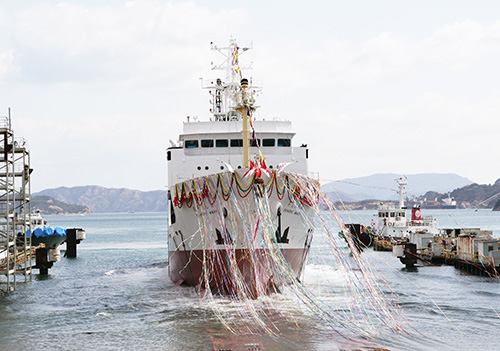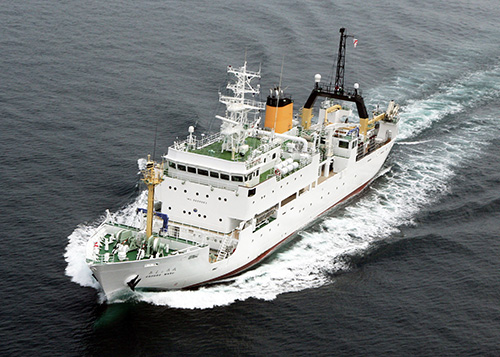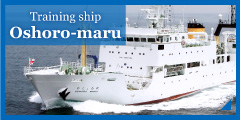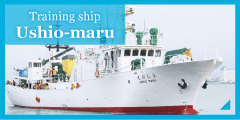BACKGROUND ON THE CONSTRUCTION OF THE OSHORO MARU
The training ship“Oshoro Maru IV” of Hokkaido University, School of Fisheries Sciences, which was built by Mitsui Engineering and Shipbuilding Co.,Ltd. in 1983, has contributed to the seamanship education and development of fisheries sciences in our country, Japan, for the last 31 years. During this period, the ocean environment and fisheries have changed significantly.
Construction of “Oshoro Maru V”, as the replacement ship of the “Oshoro Maru IV”, which is expected to cope with this change, was planned and conducted with the aim of supporting the needs of the field of fisheries sciences for the future by development of human resources who can play vital roles in the field worldwide, conservation of the ocean ecosystem, and management and securing of the seafood resources.
(Completed : July 28, 2014)

Launched March 14, 2014
FUNCTIONS AND FEATURES
The purposes for building the training ship Oshoro-maru V are to work on training and research regarding the fisheries sciences; to nurture human resources who can play an important role in this science field; to use for interchange of personnel and international collaborative research with domestic and foreign universities and research organizations; and to contribute to the reconstruction efforts of the fisheries industry that was devastated by the 2011 Tohoku earthquake and tsunami.
For these purposes of use, the ship has been designed and constructed as “an ideal fishery training ship” that will be active for a long time and provide an environment for practice of world standard research and education. The ship is also designed to succeed the high seaworthiness of the predecessor, Oshoro-maru IV, which had high sea-keeping and maneuvering performance, and furthermore, to have more sophisticated comfortability and ability for research and training considering the environmental load reduction.

Oshoro Maru V
1. Fields of experiments and training
Physical Oceanography, Chemistry Oceanography, Biological Oceanography, Marine Ecology, Marine Bioresource production, Fisheries resource Measurement, Fisheries Behavioral Research, Satellite Fisheries and Marine Technology Fisheries Informatics and Engineering, Agua culture Biology, etc.
2. Fishing methods
Stern trawling, Longline fishing, Drift gill-net fishing, Squid jigging, etc.
3. Main areas research
- Physical, chemical, biological, and ecological studies of the marine environment
- Fluctuations in sea and fishery conditions, Changes in bioresources, Resource management
- Applied physics of fishing gear, fishing methods, and fishing-gear design
- Maneuverability and stability of fishing boats
- Ecology of fishes, cephalopods, marine mammals, and plankton
- Efficiency and safety engineering of fishing machinery
- Resource measurement, Hydroacoustic remote sensing
- Metabolism, growth and reproduction of fishes
PARTICULARS
PRINCIPAL PARTICULARS
| Official number | 142155 |
| Call sign | 7JRM |
| Overall length | 78.27m |
| Length between perpendiculars | 70.00m |
| Breadth (mld) | 13.00m |
| Depth(mld) | 5.80m |
| Full load draft(mld) | 5.00m |
| Gross tonnage | 1598tons |
| International gross tonnage | 1998tons |
| Service speed | 12.5knots |
| Endurance | 10,000nautical miles |
| Complement (Officers 12, crew, 20, Teachers 7, Students 60) |
99persons |
PROPULSION EQUIPMENT
| Prime mover | Propulsion electric motor 1,000/300kWx2sets |
| Propeller | 4-blades CPPx1set |
SCHEDULE
| Keel laid | March 21, 2013 |
| Launched | March 14, 2014 |
| Delivered | July 28, 2014 |
BUILDER
MITSUI ENGINEERING & SHIPBUILDING CO.,LTD. TAMANO SHIPYARD


